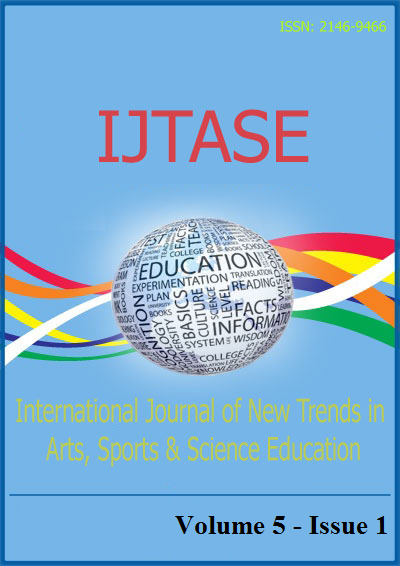ÖZ-YÖNETİMLİ ÖĞRENME ÖLÇEĞİNİN TÜRKÇE’YE UYARLANMASI VE GEÇERLİLİK ÇALIŞMASI
Abstract
TURKISH ADAPTATION AND VALIDATION OF SELF‑DIRECTED LEARNING INVENTORY
Existing SDL scales were developed primarily for elementary to middle school students (Jung, Lim, Jung, Kim &Yoon, 2012). Self directed Learning Inventory (Suh,Wang, Arterberry,2015) was developed to measure self-directness in university students after revealing that there was a lack of comprehensive measures for evaluating university students’ self-directness.In the light of the need for valid measures for evaluating the self-directness in Turkish-speaking students, SDL was adapted for secondary school students and a psychometric validation with secondary school students aged 11 - 16 from a public school located in Sakarya was conducted. The results of confirmatory factor analysis described that the 28 items loaded eight factors and the eight dimensionals model was wellfit (x²=579.75, df= 321, RMSEA=.052, NFI=.97, CFI=.98, IFI=.98, RFI=.94, AGFI=.85, SRMR=.050). The internal consistency coefficient was .93 for the overall scale.The item-total correlations of SDL ranged from .29 to .69. Overall findings of the SDL Turkish version demonstrated expected reliability and validity with adaptive abilities. Thus, this study indicates that the adapted SDL is a valid instrument for measuring secondary school children’s self-directness in Turkey.
Keywords:Self-Directed, Learning, Adaptation, Validity, Reliability.
Özet
Öz-Yönetimli öğrenme kavramına ilişkin ölçekler çoğunlukla ilkokul ve ortaokul öğrencileri için geliştirilmiştir (Jung, Lim, Jung, Kim,&Yoon,2012). Üniversite öğrencilerinin öz-yeterlik düzeylerini değerlendiren işlevsel bir ölçek eksikliğinin ortaya çıkması üzerine, üniversite öğrencilerinin öz-yeterliğini ölçmek için “Öz-Yönetimli Öğrenme Ölçeği” geliştirilmiştir (Suh,Wang, Arterberry,2015). Bu çalışmada ise, Türkçe konuşan öğrencilerin öz-yönetimli öğrenme düzeylerini değerlendirmek adına geçerlilik özelliği taşıyan ölçeklere duyulan ihtiyacın sonucunda Öz-Yönetimli Öğrenme Ölçeği’ni ortaokul öğrencilerine uygulamak üzere Türkçe’ye uyarladık. Bu doğrultuda, öncelikle psikometrik geçerlilik çalışmasını Sakarya Serdivan ilçesindeki bir devlet ortaokulunda eğitim görmekte olan yaşları 11 ile 16 arasında değişen 300 öğrenci üzerinde gerçekleştirilmiştir.Doğrulayıcı faktör analizinin sonuçları 28 ölçek maddesinin sekiz faktörle yüklü ve sekiz boyutlu modelin uygun olduğunugöstermiştir(x²=604.41, df= 322, RMSEA=.052, NFI=.97, CFI=.98, IFI=.98, RFI=.94, AGFI=.85, SRMR=.054). Ölçeğin iç tutarlılık katsayısı .93 iken toplam madde korelasyonu ise .29 ile .69 değerleri arasında hesaplanmıştır. Öz-Yönetimli Öğrenme Ölçeği’nin Türkçe uyarlamasının bulguları, uyarlanabilirliğinin yanısıra ölçeğin beklenen güvenilirlik ve geçerlilik özelliklerini de taşıdığını göstermektedir. Bu sebeple, bu çalışma ile Türkiye’deki öğrencilerin öğrenen özerkliğini ölçmede, uyarlama çalışması yapılan bu ölçeğin geçerli bir araç olduğu ortaya çıkmaktadır.
Anahtar Kelimeler: Öz-Yönetim,Öğrenme , Uyarlama, Geçerlilik, Güvenilirlik
References
Arslan, S. (2014). An investigation of the relationships between metacognition and selfregulation with structural equation. International Online Journal of Educational Sciences, 6 (3), 603-611.
Arslan, S., Gelişli, Y. (2015).Algılanan öz düzenleme ölçeği: Bir ölçek geliştirme çalışması.Sakarya University Journal of Education,5(3), 67-74
Büyüköztürk, S. (2007).Veri analizi el kitabı. Ankara: Pegem A Yayıncılık.
Brockett, R. G., Hiemstra, R.(1991). Self-direction in Learning: Perspectives in Theory, Research,and Practice, Routledge, London.
Chou,P.N., (2012). The relationship between engineering students' self-directed learning abilities and online learning performances: A pilot study.Contemporary Issues in Education Research, 5 (3),33-38
Grover, K.S, Miller T. M., Swearingen, B., Wood, N. (2014). An examination of the self-directed learning practices of esl adult language learners.Journal of Adult Education. 43 (2), 12-19
Guglielmino, L. M. (1977). Development of the self-directed learning readiness scale. Unpublished doctoral dissertation. The University of Georgia, Atherns, GA.
Harvey, B. J., Rothman, A. I., & Fredker, R. C. (2006). A confirmatory factor analysis of the ODDI continuing learning inventory (OCLI). Adult Education Quarterly, 56 (3), 188-200
Hsu, Y. C., & Shiue, Y. M. (2005).The effect of self-directed learning readiness on achievement comparing face-to-face and two-way distance learning instruction.International Journal of Instructional Media, 32 (2), 143-155.
Knowles, M S 1975.Self-directed Learning, Association Press, New York.
Merriam, S. B.& Caffarella, R. S.(1999).Learning in Adulthood, Jossey-Bass, San Francisco.
Merriam, S.B., Caffarella, R.S., Baumgartner, L.M. (2007). Learning in Adulthood: A Comprehensive Guide. (3rd). San Francisco, CA: Jossey-Bass.
Oddi, L. F. (1984). Development of an instrument to measure self-directed continuing learning. Unpublished doctoral dissertation. The Northern Illinois University, DeKalb, IL
Reeve, J. (2009). Why teachers adopt a controlling motivating style toward students and how they can become more autonomy supportive. Educational Psychologist, 44, 159-175. doi: 10.1080/00461520903028990
Roberson, Donald N.,Jr.(2005) Self directed learning past and present.Online submission.http://eric.ed.gov/?q=Self+directed+learning+past+and+present&ft=on&id=ED490435
Saeednia, Y. (2011) Self-directed learning among children of ages nine to eleven in Tehran: Generating a persian version of Sdlr-Abe.US-China Education Review.Online submission. A 4 ,511-522
Downloads
Published
Issue
Section
License
Copyright (c) 2016 International Journal of New Trends in Arts, Sports & Science Education (IJTASE)

This work is licensed under a Creative Commons Attribution 4.0 International License.





